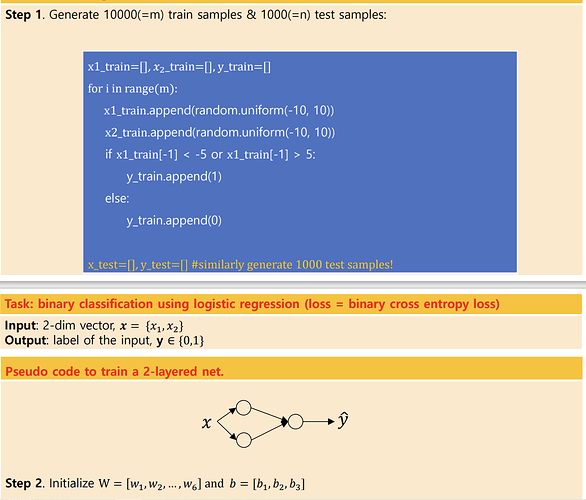import torch
import numpy as np
import torch
torch.manual_seed(42)
from torch import nn
from tqdm import tqdm
class Practice_1_3(nn.Module):
def __init__(self):
super().__init__()
self.first_linear = torch.nn.Linear(2,2)
self.second_linear = torch.nn.Linear(2,1)
# torch.nn.init.constant_(self.second_linear.bias, -0.5)
self.activation = nn.Sigmoid()
def forward(self, x):
Z1 = self.first_linear(x)
A1 = self.activation(Z1)
Z2 = self.second_linear(A1)
A2= self.activation(Z2)
return A2
def train(model,x,y,num_samples):
loss_fun = nn.BCELoss()
optimizer = torch.optim.SGD(model.parameters(), lr=0.01)
model.train()
model.to("cuda:0")
x=x.to("cuda:0")
y=y.to("cuda:0")
for k in tqdm(range(5000)):
output = model(x)
model.zero_grad()
print(output[:100])
predict = [1 if output[k] >0.5 else 0 for k in range(num_samples)]
total_loss = loss_fun(output, y)
total_loss.backward()
optimizer.step()
return model
def make_data(num_samples):
# Making data
x1_train=[]
x2_train=[]
y_train=[]
for i in range(num_samples):
x1_train.append(random.uniform(-10, 10))
x2_train.append(random.uniform(-10, 10))
if (x1_train[i]< -5 or x1_train[i]>5):
y_train.append(1)
else:
y_train.append(0)
x1_train = torch.tensor(x1_train).unsqueeze(dim=-1)
x2_train = torch.tensor(x2_train).unsqueeze(dim=-1)
x_train = torch.concat((x1_train, x2_train), dim = 1)
y_train = torch.tensor(y_train, dtype=torch.float32).unsqueeze(dim=-1)
return x_train, y_train
def main():
num_train_samples = 10000
x_train, y_train = make_data(num_train_samples)
model = Practice_1_3()
best_model=train(model, x_train, y_train, num_train_samples)
if __name__ == "__main__":
main()
This is very simple code for the picture below
I implemented it with pytorch.
But, for some reason, this code cannot train the model properly.
the accuracy score remains still 0.5 after finishing training.
I printed some values.
And I found that after passing through the sigmoid function, especially A2 in my code, output values are biased to 1, which makes all the predicted values end up with 1, leading the accuracy score to 0.5
My lecturer told me that this problem is solvable only with this simple model.
I’ve been spending lots of hours trying to fix it… but I failed.
Is there anyone who knows why this model cannot be trained.
